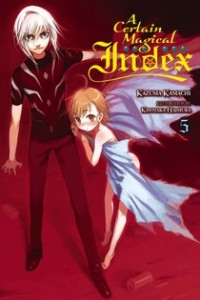By Kazumi Kamachi and Kiyotaka Haimura. Released in Japan as “To Aru Majutsu no Index” by ASCII Mediaworks. Released in North America by Yen On.
After four novels that were basically one plotline, this fifth book gathers up three interlocking stories, one a novella and two short stories, all taking place on the last day before the school semester begins. Indeed, it’s a bit startling as you get into Index to see how fast everything is moving. The 4th book, and the Angel Fall arc, took place only a few days before this. These stories also share a certain theme, which I suspect was sort of shoehorned into the non-Accelerator ones to make it work better as a book, or people choosing to do the right thing rather than let someone else do it. It’s what makes a ‘superhero’, and given that Index is in many ways about a city filled with superheroes, it rings thematically true, though in some places more than others.
Introduced in this volume: Last Order, Kikyou Yoshikawa, Eztali (as Mitsuki Unabara). There’s no real equivalent to this in the Railgun timeline, mostly as Misaka features in two of these stories. It’s still right after the final battle in the SS anime.
There’s no getting around the fact that one of these stories is much, much better than the other two, so let’s deal with the other two perfunctorily here. The scenes with Mikoto, Touma and the fake Mitsuki look to have been editorially mandated owing to a certain Railgun’s overwhelming popularity, and if you like Mikoto being the tsunnest dere in the city, there’s plenty for you to like here. But it’s very slight, and fake Mitsuki (we don’t actually learn his real name here) seems to fall for Mikoto for no real reason other than to allow the story to vaguely tie into the novels’ theme. As for the final story with Touma, Index, and Ouma, it’s even slighter (the villain is even Touma with one letter removed, though I suspect the Japanese name is suitably different). It does allow Index fans (are there Index fans?) to brag that that she’s actually a smart cookie when not whining at Touma about food or his harem hero tendencies.
But the main reason to read this, as you might guess from the cover, is the beginning of Accelerator’s journey from a mass-murdering villain to a broken anti-hero. He does a lot of soul searching here, and doesn’t like what he sees, but he can’t really see any way to redeem himself for what he’s done, and has no real reason to do so. Enter Last Order, who despite fandom’s best efforts (and the artist’s, let’s be frank) to sexualize her is pretty much written here as a “little sister” figure for Accelerator. She’s tied heavily into the Sisters project, and is able to offer him as much forgiveness as she can given the circumstances, and show off that he was not being as sociopathic as he thought. In the end, he does manage to save the girl and save the day, though it gets him shot in the head for his troubles, thus solving the other problem with Accelerator, which is that he was simply far too powerful for this series. We haven’t seen the last of him, though.
The translation continues to have the usual strengths and weaknesses, but I really have to highlight two issues. First off, Last Order’s speech quirks are very hard to translate into English at all. I don’t mind the ‘like’ inserted into her words, as it’s a casualness the other Misakas (and Mikoto herself) don’t have that works well with Last Order. But the doubling of the ‘says Misaka’ makes it look more like someone accidentally screwed up the find-and-replace rather than a genuine adaptation choice. Secondly, did Touma really say the word ‘Japanimation’? In 2015?
The three stories in this novel are of variable quality, but the Accelerator one is excellent, and it’s also the longest, so it’s definitely worth reading the book for.


Speak Your Mind